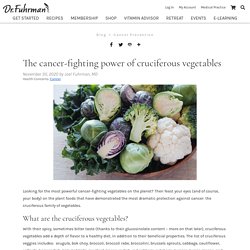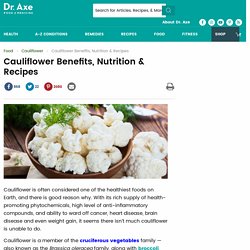

The cancer-fighting power of cruciferous vegetables. Looking for the most powerful cancer-fighting vegetables on the planet?

Then feast your eyes (and of course, your body) on the plant foods that have demonstrated the most dramatic protection against cancer: the cruciferous family of vegetables. What are the cruciferous vegetables? With their spicy, sometimes bitter taste (thanks to their glucosinolate content – more on that later), cruciferous vegetables add a depth of flavor to a healthy diet, in addition to their beneficial properties. The list of cruciferous veggies includes: arugula, bok choy, broccoli, broccoli rabe, broccolini, brussels sprouts, cabbage, cauliflower, collards, horseradish, kale, kohlrabi, mustard greens, radish, red cabbage, rutabaga, turnips, turnip greens, and watercress. You’ll find almost all of them are included in my 100 Best Foods for Health and Longevity. What makes cruciferous vegetables so special? The cruciferous family is unique among vegetables because of their glucosinolate content. Action items. Are Nightshades Bad for You? If you’ve spent any amount of time here on Mark’s Daily Apple, you know we love our vegetables.

Plant foods are powerhouses of nutrients and antioxidant action. They’re the backbone of a solid Primal diet, and the main event in my signature Big Ass Salad. But the issue of nightshades has come up quite a bit over the years. The Health Benefits of Cruciferous Vegetables. Kumato Tomato Is Patented, Yet Offers Non-GMO Benefits. For most of us, the last time we bought a beefsteak tomato that actually tasted like it should (or had any taste at all) dates back further back we can remember.

The organic sometimes taste better, but your tongue can still tell they were picked when green. Organic heirloom tomatoes would be the preferred choice for flavor. However those aren’t always available and when they are, who can afford several pounds of those honkin’ things?! Enter the Kumato, which has real taste, wide availability, and comes at a reasonable price point. What are Kumato tomatoes? Developed by Syngenta, which is a publicly-traded biotech agribusiness, Kumato is the consumer brand name for a patented tomato cultivar.
The size of a Kumato is smaller than an average tomato. The US and foreign patent filings for SX 387, which are also known as Olmeca tomatoes, use vague language which makes it difficult to discover the plant’s exact lineage.
Root Vegetables. Bearers of the Cross: Crucifers in the Context of Traditional Diets and Modern Science. Cauliflower Benefits, Cauliflower Nutrition & Cauliflower Recipes. Cauliflower is often considered one of the healthiest foods on Earth, and there is good reason why.

With its rich supply of health-promoting phytochemicals, high level of anti-inflammatory compounds, and ability to ward off cancer, heart disease, brain disease and even weight gain, it seems there isn’t much cauliflower is unable to do. Cauliflower is a member of the cruciferous vegetables family — also known as the Brassica oleracea family, along with broccoli, cabbage, kale, Brussels sprouts and some other less common varieties.
Extensive studies suggest that cruciferous vegetables are an excellent source of natural antioxidants due to their high levels of various phytochemicals, as well as good suppliers of essential vitamins, carotenoids, fiber, soluble sugars, minerals and phenolic compounds. In fact, it’s believed that Brassica oleracea vegetables are the largest source of phenolic compounds in the human diet. (1) Unique Nutrition Profile of Cauliflower 1. 2. 3. 4. 5. 6. 7. 8. History. Butternut Squash Nutrition, Benefits, Uses & Recipes. Sometimes, the best foods are underrated, but I hope that’s not the case when it comes to butternut squash.

This creamy food hasn’t been around long, but it’s quickly become an incredibly common (rightfully so!) Part of many healthy diet routines thanks to all the wonderful things butternut squash nutrition provides. Why is this such a good thing? Could it be perhaps because butternut squash has enough vitamin A in just one serving to cover your entire day? Maybe it’s because butternut squash nutrition can help you lose weight, prevent cancer and even avoid catching a cold. All of these reasons (and many more) are great reasons to incorporate butternut squash into your diet — and lest we forget, it also tastes great. Butternut Squash Nutrition Facts Butternut squash is part of the Cucurbita family of fruits, specifically known as one of the six varieties of Cucurbita moschata.
The incredible nutritional value of butternut squash is difficult to overstate. 1. The moral of this story? 2. Raw Sprouts: Benefits and Potential Risks. Vegetables - Diagnosis:Diet. We are told that vegetables are powerful and virtuous—that they fight off cancer, sweep our digestive systems clean, and strengthen our immune system —that they can leap tall buildings in a single bound.

Yet vegetables have a dark side. They don’t want to be eaten any more than animals do, and use sophisticated chemical weapons to defend themselves… Watch a video of my presentation entitled “Little Shop of Horrors: The Risks and Benefits of Eating Vegetables” given at the 2012 Ancestral Health Symposium at Harvard University. Vegetable Psychology We think of them as virtuous, vital components of a healthy diet, yet vegetables are cunning and manipulative. Deep down they don’t care about us. Pretend you are a plant. You can’t run away from animals that stop to dine on you. How do you protect yourself? Well, you might have thorns or other special structures to help deter some invaders, but mostly you use chemical weapons…and very sophisticated ones, at that.